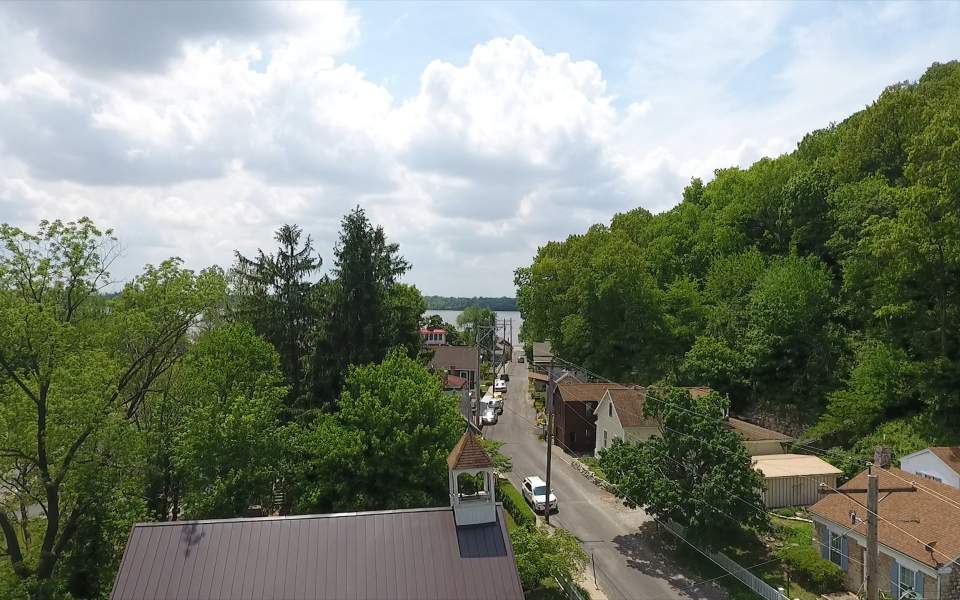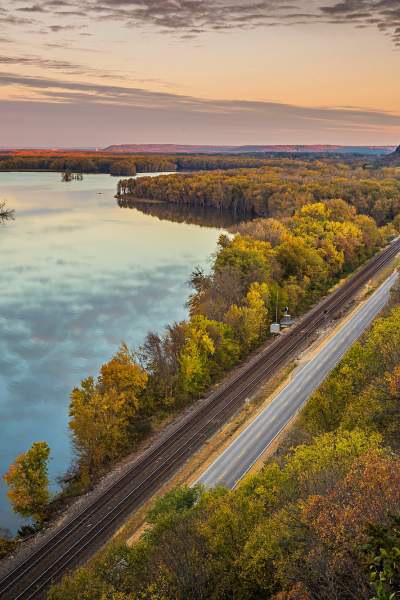
The Great River Road meanders along the Mississippi, the western border of Illinois, through historic river towns, past state parks and towering bluffs.
It's one of Illinois' most scenic experiences, and many of Illinois' most beloved scenic gems sit along its path between Galena and Cairo. Join us as we explore what you can find along the way — but remember, nothing can match exploring it for real.

Galena: Linmar Gardens
Galena is one of the jewels of Illinois, and our first stop on the Great River Road.
Linmar Gardens is built on the site of a disused stone quarry, perched above Galena's Main Street. These private gardens offer guided tours mid-May through October.
Three acres of shady woodland gardens include a waterfall tumbling from a bluff, creeks, wildflower meadows, ponds with koi carp, charming sculptures and gazebos. At the heart is the Sunken Garden, built on the foundations of an old church, the tumbledown walls of which still remain.

Mississippi Palisades State Park
Driving south along the Great River Road to the Mississippi Palisades State Park, you'll find the Sentinel Rock loop trail.
It’s a short walk, only one mile, but along narrow rocky paths close to the bluffs, overlooking the river. The park is lovely, wooded and rocky, and you can feel like you've got the whole place to yourself.

Quad City Botanical Center
The Quad City Botanical Center does not disappoint. Highlights include its Tropical Sun Garden with 14-foot waterfall, and delightful Children's Garden, with a theme of "fours" (remember, it's Quad City).
The Center is right by the Mississippi, so once you've had your fill of flowers and trees, you're situated perfectly for a nice riverside stroll before you take to the road once more.

Quincy Time & Thyme
Time for lunch? Thyme Square, with its farm to plate philosophy, is a great stop.
Once you've got that business out of the way, take some time to stretch your legs and admire Quincy's historic architecture. Its whole downtown area is listed on the National Historic Register!
Towards the East End Historic District, the street widens and historic mansions take over from the historic shops. The Quincy Museum is a great stop, with ornate gilded woodwork and scale models of historic archaeology sites in Illinois.

Onwards to Elsah
Then it's onwards to Elsah, with historic Nauvoo on the way, and the most scenic part of your drive so far, the Meeting of the Great Rivers National Scenic Byway.
Next, Elsah. It's a tiny historic village nestled in a valley between the bluffs, which some have called Illinois' top scenic spot. With peaceful old stone houses and less than 100 permanent residents, the whole village makes you feel as if you've stepped through a door to the past.

End at a Beginning: Cahokia Mounds
At the end of your journey, you can see where so much began.
Visiting Cahokia Mounds is a fascinating experience. This "Manhattan of early America" is a UNESCO World Heritage Site representing 1300 years' of history. Where today are empty fields and gentle (but unmistakable) mounds was once a thriving settlement, the largest prehistoric civilization in the Americas north of Mexico.
Here, with every footstep, you add to its story.


